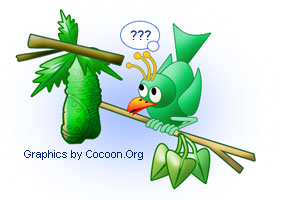How long Cocoon last?
 The cocoon is also know as the larval stage of an insect. This is the part of the life cycle that follows the pupal stage, which is when the insect is born and hatches from its egg. However, it comes before the imago stage, which is when the insect becomes a fully functional adult with wings (if they have them) and a reproduction system that is now completely working.
The cocoon is also know as the larval stage of an insect. This is the part of the life cycle that follows the pupal stage, which is when the insect is born and hatches from its egg. However, it comes before the imago stage, which is when the insect becomes a fully functional adult with wings (if they have them) and a reproduction system that is now completely working.
It is between the pupal stage and the imago stage that an insect will enter into a cocoon that they themselves have made by secreting silk from 2 glands that are located inside of them. This thread will stick together and grow hard when fresh air touches them.
While inside of the cocoon, the insect’s adult structures are formed and the juvenile structures, which are also known as larval structures, are broken down. During their time inside of their cocoon these insects are very inactive as they stay in their cocoon that is located in a place that is both cool and moist.
Their cocoon provides them with a hard protective coating that is oftentimes camouflaged so that predators cannot see them. In this manner, they are able to keep from being eaten while they stay there for anywhere from 2 weeks (monarch butterflies) to an entire season (wintertime in temperate climates and during the dry season in the tropics).
Insects will then emerge from their cocoons by splitting it open. Some insects have mouthparts that they use to bite their way out while others use “spit” to soften 1 of the ends of the cocoon so that they can then push their way through the fibers. As you can see, the way in which an insect escapes from their cocoon depends upon how its “body” is built. When this happens is controlled by their hormones. While butterflies emerge in the morning, mosquitoes emerge at night.
Bee Cocoons
What is a Cocoon
Cocoons in the winter time
How long Cocoon Last?
Silk Made From Cocoon
Silkworm Cocoon
Orgin of word Cocoon
The Surprises in Cocoons
Types of Insects in Cocoon
Butterfly or Moth Cocoon
Making of Cocoons
Ant – Cocoon Connection
From Cocoon to Adult: Role of Hormones
Cocoon that resembles a Bag
Cocoon Architecture
Mud Cocoons
Interesting Cocoons
Cocoon Food
Glochidium Cocoon
Sleeping Bag Cocoon
Cremaster, Nature’s Velcro
Frog Cocoon
Earthworm Cocoonv
Cocoon Rattles
Mites And Bee cocoon
Say No to Silk
Cocoon Inside Cocoon
Sensing From Inside Cocoon
Cocoon That Resembles Rabbit droppings
Hammock Shaped Cocoon
Chipwood Cocoon
Slime Cocoon
Cocoon For Eggs
